Ita Yachts Canada
Brokerage / Courtage

Understanding the Classification of Yachts A, B, C and D
Understanding the Classification of Yachts A, B, C and D:
Since 1998, Europe (EEC) classifies yachts according to 4 categories A or B or C or D and this is a law. In order to sell a boat in the large territory of the EEC, it must be classified with a plate that mentions its classification and it must be clearly visible inside the boat, usually near the helm.

At first glance, it sounds very good when you hear class A, but what is it really, what are the differences, is it necessary to acquire a class A…
The brokers at ItaYachtsCanada have written an article on this subject in the past ( click here ), but here are the important characteristics to know about the subject.
The classification allows you to know in which kind of sea intensity you can safely venture, that is to say, taking into account the wind and the wave height in reference to the Beaufort index.
(At the end of this text, there is an explanation of the classes according to the Beaufort index).
Let’s say we focus on class A and B, on the major differences.
First of all, the differences are not very visible to the naked eye or it takes a trained eye to see them.
Depending on the type of water you plan to sail and if the weather guides you on each trip, a B class is also a very good choice.
Of course, you must have all the required safety equipment on board.
Ideally, a boater should always sail in rather peaceful conditions, taking into account the weather first. We always say that boating is fun, so stay away from difficult sailing situations. (Ideally, always with a Beaufort index of 6 and less, ideally a Beaufort index of 4 and less).
Many manufacturers have retained the parameters of the B class to build their boats, mainly for reasons of production costs and that boaters in general do not care much about these characteristics.
The problem is how to differentiate between the vast range of B class boats, how to distinguish those that are closer to an A class (B +) from those that are built as (B -).
How to find your way around, especially for a layman…

It is important to know that some manufacturers build their boats with an A approach, but without respecting all the mandatory specifications to be classified A.
Here are some guidelines to quickly see if the manufacturer has done things right.
– Inspect the portholes and closing mechanisms (Plastic or Metal)
– The presence of numerous drains to evacuate water (at the fly and cockpit), it is essential to be able to evacuate any water accumulation quickly.
– Height of the freeboard.
– Engine access hatch, well insulated and secured for water leaks.
– Bilge pumps (number, size and capacity)
– Mechanism to pump water from the engine room massively (e.g. possibility to use the engine water pumps with a joystick)
– The center of gravity of the boat is well balanced (rather low).
Hull joints, a very low center of gravity, excellent weight distribution, electrical system (24 V), are also part of the certification criteria especially for A boats, but difficult to assess for a yachtsman. It is possible, but in a summary way.
The CE classification allows to differentiate yachts according to certain criteria present, we are talking mainly about structural strength, integrity of essential parts of the hull, reliability of propulsion, steering systems, power generation and all other features installed on board to help ensure the essential services of the yacht.
Therefore, it is important to understand that a Class A yacht is built to a much higher standard than a Class B. This is not reflected in the luxurious appearance of the boat.
What you have to remember is that the major enemy for a boat, besides a fire, is water infiltration on board which can destabilize the behavior of the boat, cause a stop of the engines, major electrical problems, in short which can quickly put the boat out of use and/or out of control.
A classification body such as RINA (see list at the end of this text) has been checking the activities of builders and classifying yachts for over 20 years.
If the boat is sold in the European Community, the classification is mandatory and must be visible near the cockpit. This same classification is not present when the boat is intended for North America or very rarely.
Do not hesitate to contact a professional broker, he will be able to guide you according to your needs, your criteria and especially the places of navigation.

As the CE classification is not always displayed when the boat is destined for the North American market, here are some references on this subject based on the most recent data available (subject to change without notice):
P.S. Let’s mention that as a general rule yachts over 80 ft are Class A, but according to the rules in place, the classification is no longer mandatory or mentioned beyond 79 ft.
Class A (yachts over 50 ft):
BEST KNOWN MODELS :
Ferretti 500, 550, 670 and up
Pershing : 7X and up
Azimut 62, 64, 66, 68 Fly and up
Azimut S8 and up
Azimut Magellano : the whole range
Sunseeker Sport yacht 65, Yacht 88 and up
Princess yacht 80 and up (TBC)
Marquis Yachts (no longer in production)
Montecarlo MCY 66 and up
Searay L650
Class B (yachts over 50 ft):
Sunnseeker 52 fly, 55 fly , 66 fly, 68 fly, Sport Yacht 74, 76 Yacht
Azimut 50 fly, 55 fly, 60 fly, S6 and all Atlantis
Princess : all yachts under 70 ft
Princess Y72, Y78 and less
Ferretti 580 fly
All Absolute
All Fairline
All Beneteau & Jeanneau & Monte Carlo 52
All Searay except L650.
All Cruisers Yachts
For more information, here is an article published by the brokers at ItaYachtsCanada, click here .
There is also the dry weight which can help determine a quality yacht.
Don’t hesitate to compare yachts of the same size based on dry weight, you may be surprised.
For example, a 52′ yacht that weighs 30,000 lbs empty compared to another one that weighs 60,000 lbs empty, ask yourself some questions.
But be careful, it is more and more difficult to get the manufacturers’ empty weights. They have understood the importance of being rather vague on the subject or of making comparisons more difficult. Indeed, we are talking about LIGHT WEIGHT, which is difficult to measure.
The manufacturer who has confidence in thier boat will have no difficulty in giving a total warranty of at least 12 months, 24 and even 36 months. Please note the difference here between the manufacturer’s warranty and the dealer’s warranty .
Many European manufacturers sell their boats to dealers in America without a warranty. This means that the dealer assumes the full 12-month warranty out of his profit from the sale. The engine manufacturer, on the other hand, honors its own warranty such as Volvo, Cummins, Caterpillar, MAN, MTU, Yanmar. For other major components, it will be up to you to take the necessary steps to have the warranty honored, such as for the generator, the air conditioning, the thrusters, etc…

Therefore, acquiring a boat requires a much more specialized expertise than that of a car! Contact ITA Yachts Canada Inc. to speak with a professional and independent broker with experience in the following markets (Canada, United States and Europe whether the boat is new or used).
MORE INFORMATION.
Here is some more information about the classification, what the law in Europe says about it.

Here are some links to help you understand the Beaufort index in direct relation with the classification of yachts sold on the territory of the EEC:
Click here for the TRANSPORT CANADA website
Click here for an article on Wikipedia (more descriptive with photo).
According to the EEC rules, here is the description:
The classification of vessels marked “CE
CE marked vessels are classified into four design categories according to their ability to cope with sea conditions characterized by wind speed and significant wave height. Depending on the type of navigation practiced, the boater must choose a vessel whose design category authorizes such practice.
– Design Category A: Recreational vessels designed for winds that can exceed force 8 (on the Beaufort scale) and for waves that can exceed a significant height of 4 meters, excluding exceptional conditions such as storms, severe storms, tornadoes and extreme sea conditions or huge waves (these conditions exclude force 10 and following).
– Design Category B: Pleasure craft designed for winds up to and including force 8 and for waves up to and including 4 meters in significant height.
– Design Category C: Pleasure craft designed for winds up to and including force 6 and for waves up to and including two meters in significant height.
– Design Category D: Pleasure craft designed for winds up to and including force 4 and for waves up to and including 0.30 meters, with occasional waves up to and including 0.50 meters.

Vessels in each of these design categories shall be designed and constructed to withstand the parameters of each of these categories, with respect to buoyancy, stability and other relevant requirements, and to have good maneuverability characteristics.
The known classification bodies for the EEC:
RINA (Registro Italiano Navale),
BV (Bureau Veritas),
DNV (Det Norske Veritas),
Germanischer Lloyd,
LR (Lloyd’s Register).

Ita Yachts Canada provides the information in this article in good faith but cannot guarantee the accuracy of the information or the status of the data. It is the responsibility of the reader to instruct their agents or experts to verify and validate the information in this article.
Share this:
Published by Guy Bolduc
View all posts by Guy Bolduc
Leave a Reply Cancel reply
Discover more from ita yachts canada.
Subscribe now to keep reading and get access to the full archive.
Type your email…
Continue reading
- CATAMARAN MOTEUR
- CATAMARAN VOILE
- CENTER CONSOLE
- FISHING BOAT
- SPORT BRIDGE
- ABSOLUTE YACHTS
- CRUISERS YACHTS
- FOUNTAINE PAJOT
- GRAND BANKS
- KADEY-KROGEN
- MOCHI CRAFT
- MINIGHT EXPRESS
- MONTE CARLO
- NORTHERN MARINE
- OCEAN ALEXANDER
- OUTBACK YATCHS
- PARDO YACHTS
- PRESTIGE YACHTS
- SILENT YACHTS
- $1,5 M to $2,9 M
- $3,0 M to $4,9 M
- $5,0 M to $6,9 M
- $7,0 M to $9,9 M
- $10,0 M and more
- UNDER 49 FEET
- 50 to 59 FEET
- 60 to 69 FEET
- 70 to 79 FEET
- 80 to 89 FEET
- 90 to 99 FEET
- MORE THAN 100 FEET
- CENTRAL AMERICA
- PERSIAN GULF
- UNITED-STATES OF AMERICA
- YACHTS REGISTERED UPDATED
- VIRTUAL TOUR 3D
- YACHTS FOR SALE
- IMPORT-EXPORT
- BLOGUES, NOUVELLES ET CONSEILS
- PODCAST VIDEO

Class Notations on Yachts – Classification Guide
9 December 2016
INTRODUCTION TO YACHTS CLASSES
Classification.
Rules are developed to establish standards for the structural strength of the large yacht’s hull and its appendages, and the suitability of the propulsion and steering systems, power generation and those other features and auxiliary systems which have been built into the ship to assist in its operation, and even pollution protection systems. A yacht may be maintained in class provided that, in the opinion of the Society concerned, it remains in compliance with the relevant Rules, as ascertained by a periodic or non-periodic survey(s). Today a vessel either meets the relevant Class Society’s Rules or it does not. As a consequence, it is either “in” or “out” of “Class”.
In summary, Class Notations on Yachts will tell you a lot about the building quality and condition of each vessel and its components on an annual basis, according to the excellence of its construction and its adjudged continuing soundness. A yacht that has been designed and built to the appropriate Rules of a Society may apply for a Certificate of Class from that Society or for a periodical survey (generally required every 5 years) meant for the Renewal of Class Certificate . Class Societies have often developed two separate sets of Rules for Commercial and Private Yachts . They can be applied to New Construction as well as Existing Yachts .
Classification Societies
Classification Societies play a fundamental role in today’s marine industry. A Society will act on behalf of ship-owners and builders to ensure high build quality and the safety of a ship’s main structural parts . Classification also provides a point of reference with regard to those who were involved in the supply chain including builders, charterers and insurers.
As an independent, self-regulating, externally audited, body, a Classification Society has no commercial interests related to ship design, shipbuilding, ship ownership, ship operation, ship management, ship maintenance or repairs, insurance, or chartering.
The process begins with the design and construction phases, focussing on the implementation and manufacture of key components as well as technical specifications. The standards which must be adhered to are dictated by the regulations of the chosen society and are published as rules, evolving continuously to incorporate new technologies and client requests via the advice of highly competent engineers and architects.
All Classification Societies waive liability for future faults as a surveyor can only record a vessel’s quality at the time of inspection; it is then the responsibility of the yacht owner to maintain the vessel and inform the society in the event of damage or structural alteration. Although the surveys are thorough, they do not cover all aspects of a ship’s build and operating service. This can include crew qualifications, navigational aids and manoeuvrability.
Classification Societies are often simply referred to as “Class Societies” or just “Class”. There are currently 13 members of the International Association of Classification Societies (IACS) , each with a unique set of rules, classification layouts and notations. Five of the biggest Classification Societies are listed below, along with their identifying signature, to denote a ship constructed under special survey in compliance with the Society’s rules, suitable for unrestricted sea-going service:
The marks following the Society’s standard signature are not interchangeable between organizations, meaning each letter or number will represent a different characteristic for each society. Each mark can be broken down to highlight a yacht’s capabilities, equipment or restrictions.
Each of the Classification Societies has developed a series of notations that may be granted to a vessel to indicate that it is in compliance with some additional voluntary criteria that may be either specific to that vessel type or that are in excess of the standard classification requirements.
The Classification of a yacht does not absolve the Interested Party from compliance with any requirements issued by Administrations and any other applicable international and national regulations for the safety of life at sea and protection of the marine environment such as SOLAS, ILLC, MARPOL, ILO or IMO.
Smaller vessels are categorized differently, adhering to different requirements and statutory regulations. With a heavier focus on passenger numbers and distance of operation from shore, the Maritime and Coastguard Agency (MCA) outlines guidance for UK vessels (up to 24 meters in length) which are used for charter or commercial use.
As RINA is today the most reputed Classification Society in the Mediterranean and a leader in the yachting certification business, developing and offering services of ships classification, certification, verification of conformity, inspection, and testing, we will hereby provide you with a summary of their more common Class Notations on Yachts , this will be helpful to identify these most peculiar symbols :
CLASS NOTATIONS – RINA
Main class symbol.
The main class symbol C is assigned to ships built in accordance with the requirements of the Rules or other rules recognized as equivalent and maintained in a condition considered satisfactory by the Society. The period of class (or interval between class renewal surveys) assigned to a ship is a maximum of 5 years.
Except for special cases, a class is assigned to a ship only when the hull, propulsion and auxiliary machinery installations, and equipment providing essential services have all been reviewed in relation to the requirements of RINA’s Rules.
With the 5 year class period is to be understood as being the highest class granted by the Society.
Construction Marks
The construction mark identifies the procedure under which the yacht and its main equipment or arrangements have been surveyed for the initial assignment of the Class.
Construction marks defined below are assigned separately to the hull of the yacht and its appendages, to the machinery installation.
The construction mark is placed before the symbol HULL for the hull, before the symbol MACH for the machinery installations, and before the additional Class Notation granted, when such a notation is eligible for a construction mark.
When the same construction mark is assigned to both hull and machinery, the construction mark is assigned globally to the ship without indication HULL and MACH after the main class symbol.
Hull Construction Mark (HULL)
- Construction mark ✠ is assigned to the hull when it has been surveyed by RINA during its construction in compliance with the new building procedure.
- Construction mark ✠ is assigned to the hull when it was built under the survey of another Society.
- Construction mark ● is assigned to the hull in all cases other than those listed above.
Machinery Construction Mark (MACH)
- The construction mark ✠ is assigned when the propelling and auxiliary machinery has been designed, constructed, certified, installed and tested in accordance with RINA Rules.
- The construction mark ✠ is assigned when the propelling and auxiliary machinery has been designed, constructed and certified in accordance with the rules of another society and installed and tested under the survey of RINA.
- Construction mark ● is assigned in all cases other than those listed above.
Navigation and Operating Notations
The navigation notation UNRESTRICTED NAVIGATION is assigned to a ship intended to operate in any area and any period of the year.
Restricted operating area notations are optional and will be marked accordingly like, for example, on a specified operating area or operation service within “x” miles from shore.
Additional Class Notations
An additional Class Notation expresses the classification of additional equipment or specific arrangement, which has been requested by the Interested Party. The assignment of such an additional Class Notation is subject to the compliance with additional rule requirements.
Some additional Class Notations, due to the importance of relevant equipment or arrangements, are assigned a construction mark. This is indicated in the definition of the relevant additional Class Notations. Class Notations which may be assigned to a ship are listed according to the category to which they belong:
Automated Machinery Systems (AUT)
AUT notations are relevant to automated machinery systems installed onboard ships.
Automated machinery systems (AUT – UMS (Y))
The additional Class Notation AUT-UMS (Y) may be assigned to yachts that are fitted with automated installations enabling machinery spaces to remain periodically unattended in all sailing conditions including manoeuvring.
Integrated Ship Systems (SYS)
SYS notations are relevant to the operation of integrated systems regarding navigation, machinery, communication and specific cargo, as applicable.
Centralised Navigation Equipment (SYS-NEQ)
The additional Class Notation SYS-NEQ is assigned to yachts which are fitted with a centralized navigation control system so laid out and arranged that it enables normal navigation and manoeuvring operation of the ship by two persons in cooperation.
Centralised Navigation Equipment (SYS-NEQ-1)
The additional Class Notation SYS-NEQ-1 is assigned when, in addition to the above, the installation is so arranged that the navigation and manoeuvring of the yacht can be operated under normal conditions by one person, for a periodical one-man watch. This notation includes specific requirements for the prevention of accidents caused by the operator’s unfitness.
Integrated Bridge System (SYS-IBS)
The additional Class Notation SYS-IBS is assigned to yachts which are fitted with an integrated bridge system which allows simplified and centralized bridge operation of all main functions of navigation manoeuvring and communication, as well as monitoring from the bridge of other functions related to specific cargoes and pollution; for passenger ships, heating, ventilation and air conditioning are also included in the monitored functions
Communication System (SYS-COM)
The additional Class Notation SYS-COM is assigned to yachts which are fitted with a local area network including the alarm, monitoring and control systems and computers used for management operations and external communication devices for reporting ashore navigation, maintenance and operational information.
Damage Stability (DMS)
The additional Class Notation DMS may be assigned to yachts complying with the damage stability requirements.
STAR Notation
General STAR is a System of Trace and Analysis of Records integrating rational analysis with data and records from ship-in-service concerning planned inspection and ship maintenance.
The additional Class Notation STAR-HULL is assigned to ships on which an Inspection and Maintenance Plan (IMP) for the hull is implemented.
The notation may be completed by the suffix NB when a structural tridimensional analysis has been performed for the hull structures, at the new building stage. The suffix NB is removed when the ship enters the STAR-HULL survey program through the implementation of the Inspection and Maintenance Plan (IMP).
The additional Class Notation STAR-MACH is assigned to yachts on which an Inspection and Maintenance Plan (IMP) for the machinery is implemented. This plan is based on a risk analysis review of the installation.
STAR Notation (STAR)
When yachts are granted both STAR-HULL and STAR-MACH, the two separate notations are superseded by the cumulative additional Class Notation STAR.
Crew Accommodation and Recreational Facilities (MLCDESIGN)
According to the Maritime Labour Convention 2006 Notation:
The additional Class Notation MLCDESIGN is assigned to yachts having crew accommodation and recreational facilities complying with the Maritime Labour Convention 2006 (MLC).
GREEN PLUS Notation (Eco-Friendly Yachts)
Issued in 2008 and updated yearly, the GREEN PLUS additional Class Notation has been revised in 2012 to cover new issues for seagoing ships and ships operated at a fixed location. The additional Class Notation GREEN PLUS is assigned to Eco-Friendly yachts compliant with the Society’s environmental protection framework of airborne gases, spillage/leakage of substances, oil, sewage, greywater, garbage disposal and noise mitigation systems to prevent pollution.
Safety Class Notation EFP (Bureau Veritas)
The following additional Class Notations are assigned to yachts complying with the requirements of this Section:
- EFP-A : for yachts having Enhanced Fire Safety Protection in accommodation spaces,
- EFP-M : for yachts having Enhanced Fire Safety Protection in machinery spaces,
- EFP-C : for yachts having Enhanced Fire Safety Protection in cargo areas,
- EFP-AMC : for yachts complying with all the requirements of this Section.
For more information on Class Notations on Yachts – Classification of Yachts , please feel free to contact Allied Yachting .
OUR YACHT LISTINGS:
- New Yachts for Sale
- Pre-owned Yachts for Sale
- Yachts for Charter
You might also like
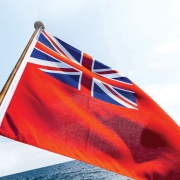
Yachting Consultants
Sale-Charter-Brokerage-Management
Headquarters:
34 Rue Caffarelli 06000 Nice, France
Front Office:
Boulevard de La Croisette – Port Canto 06400 Cannes, France
T.: +33 493 43 82 83 Email: [email protected] Website: www.alliedyachting.com

- THE PRINCESS PASSPORT
- Email Newsletter
- Yacht Walkthroughs
- Destinations
- Electronics
- Best Marine Electronics & Technology
- Boating Safety

- Uncategorized

Yacht Classifications
- By Dudley Dawson
- Updated: July 17, 2009
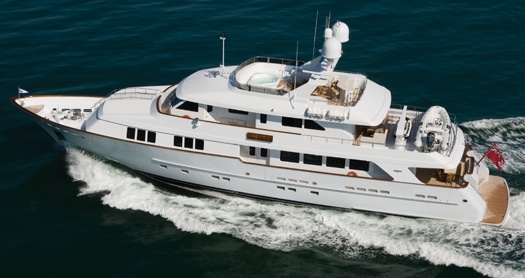
ytgjul17perf525.jpg
Let’s take a peek into the dark back corner of a London pub a couple hundred years ago, when Britain was the unquestioned ruler of the sea, as a group of Lloyd’s of London insurance underwriters licked their financial wounds from the latest loss of a cargo ship to Davy Jones’s locker. They’d had enough, and proposed to form an independent society to make ships safer by developing standards for construction, operation, and maintenance. Thus was born Lloyd’s Register of Shipping, no longer affiliated with Lloyd’s of London, but still the granddaddy of maritime classification societies.
The concept was so successful in improving safety and cutting losses that spinoffs and imitators soon appeared in other seagoing nations. There are now ten full members and one associate member of the International Association of Classification Societies ( www.iacs.org.uk ). Not all of them class yachts, and of those who do, not all class smaller yachts. The American Bureau of Shipping (ABS), for instance, does not class yachts under 24 meters, or about 79 feet, in overall length.
Each society also has different sets of rules and guides, several of which will be applicable to any given yacht. While national codes, such as the U.S. Coast Guard regulations, and international treaties, such as SOLAS, are mandatory, classification is in most cases voluntary. A shipowner or yachtowner elects to have his vessel classed in order to better assure a certain level of sound design and construction, and consequently, to reduce insurance premiums and losses.
Although there are differences in the details, the societies have much in common. Each issues written rulebooks and guides for use by designers, reviews and approves the vessel plans in advance of construction, and employs dedicated surveyors to assure that the vessel is built in accordance with the plans. There are also periodic inspections by this same corps of surveyors throughout the vessel’s service life to check that it is being maintained to the required standards.
The voluntary nature of classification creates a number of possibilities for a yacht owner. He can pick and choose from the several classification societies that cater to yachts. For instance, an American owner having a fast yacht built in Holland could choose to have it classed by the Norwegian society, DNV (Det Norske Veritas). This is where those detail differences come in, as some designers consider the DNV construction rules for high-speed vessels to be more realistic than those drafted by some other societies. Such shopping for classification is commonplace, and that’s why you’ll find surveyors for each society in each shipbuilding nation. In an Italian yard, for instance, you might find an ABS surveyor working on one vessel and a Lloyd’s inspector working on another, alongside the first. In some cases, where the surveyors are independent, or “non-exclusive” in society parlance, you might find him wearing a DNV jumpsuit one day and ABS coveralls the next.
In addition to choosing his classification society, an owner can choose the level of involvement he wants with classification. Full classification means plan approval before construction, inspection and approval of both construction and installed equipment (anchors, engines, generators, etc.), and periodic inspections and required maintenance after delivery. An owner can also add various options, including most recently, an environmentally based endorsement of the yacht as “green.”
All of this comes at a price, of course, both in meeting the initial requirements and in continuing costs. Some owners view any financial outlay as justified in protecting their vessel and those aboard; others elect to have the yacht designed and built to class, and then drop the class designation when fees and mandated maintenance expenses begin to exceed the savings in insurance premiums.
Finally, an owner can opt to have his designer and builder use the written classification standards as a guide in the construction of his new vessel, without actually contracting with the society. This avoids some of the expenses of questionable value, such as factory testing and equipment certification. Then an independent non-society surveyor or project manager can oversee the construction up to delivery, and the captain, vessel management firm, or favorite boatyard can track maintenance requirements. It’s not official, but it’s still classy.
- More Uncategorized

BoatUS Launches Online Advocacy Tool

Dock Danger

A Dream Fulfilled

3 America’s Cup Hashtags to Follow
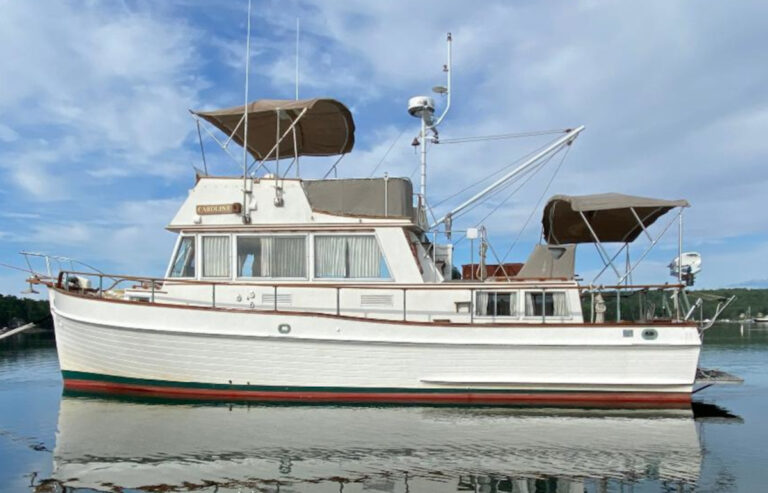
For Sale: Grand Banks 36 Classic
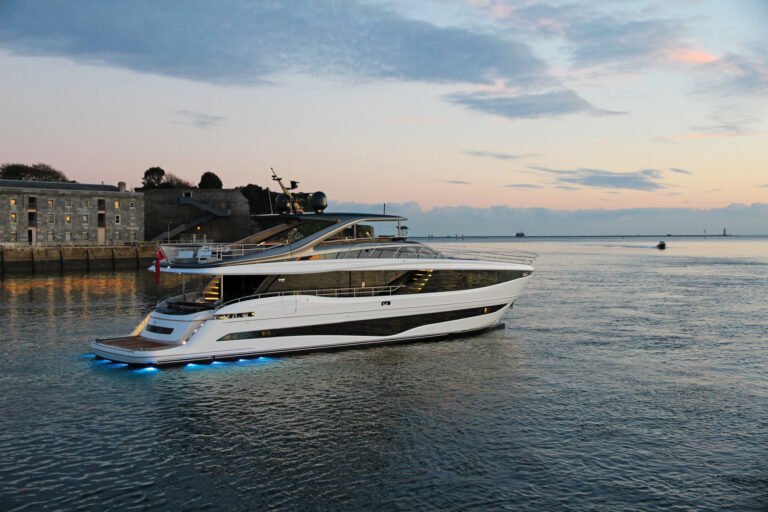
Princess Yachts’ Y95: A Flagship Flybridge
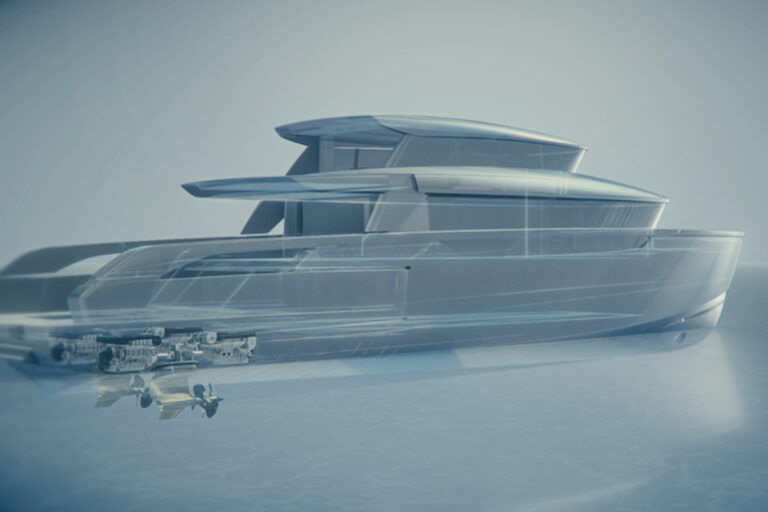
Sanlorenzo, Volvo Penta Announce Partnership
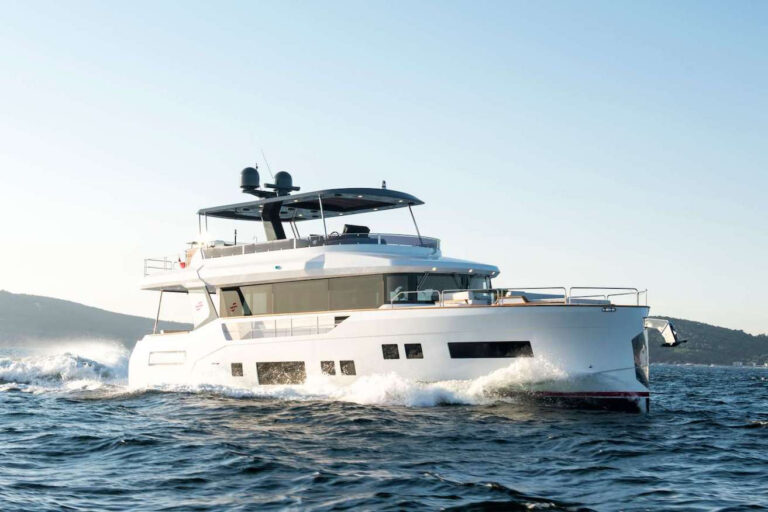
For Sale: 2023 Sirena 68

- Digital Edition
- Customer Service
- Privacy Policy
- Terms of Use
- Email Newsletters
- Cruising World
- Florida Travel + Life
- Sailing World
- Salt Water Sportsman
- Sport Fishing
- Wakeboarding
Many products featured on this site were editorially chosen. Yachting may receive financial compensation for products purchased through this site.
Copyright © 2024 Yachting. A Bonnier LLC Company . All rights reserved. Reproduction in whole or in part without permission is prohibited.
- Advertise in AFLOAT
Legendary ‘D’, Undine brought back to life
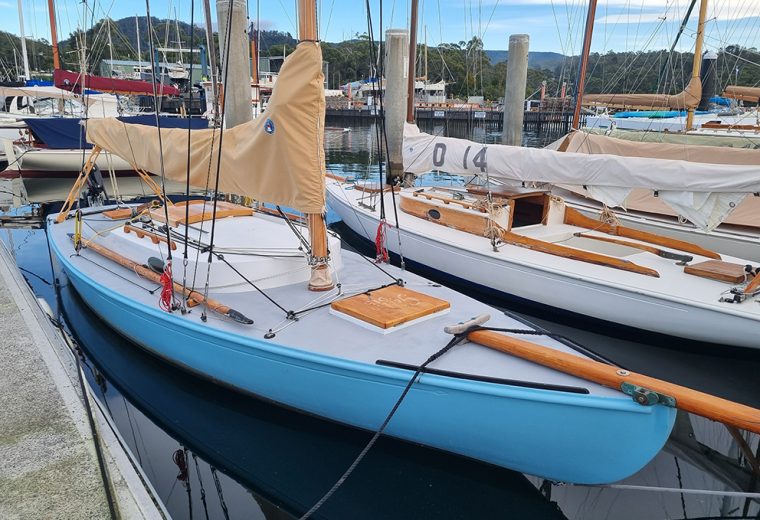
An iconic Derwent Class yacht called Undine is undergoing restoration in the hands of the talented team at The Wooden Boat Centre, Tasmania, destined for the racing circuit in time for the Kettering Wooden Boat Rally in February 2024.
According to Cordy Horgan, Head Shipwright and Manager of the Wooden Boat Centre (WBC) – Australia’s only wooden boat building school – the project will involve the WBC’s team of four, a couple of ex-students and volunteers over the next six months.
“We officially began 1 June, and we’re aiming to finish by November and have her sailing in December, ready for the Rally in February. Our team will be joined by local volunteers who are passionate about wooden boats, and ex-students, Sarah and John.
“Only the hull and mast remain,” he continues. “We have to recreate everything else and fully re-rig her. There’s a painting and an old set of plans which are hard to follow, but we’re trying.
“The first step is the restoration of the hull, checking to make sure its intact. Then the second phase is the deck and cabin, followed by the rigging and caulking to get it back on the water.”
Whimsically named Undine for the water nymph who could only become human if she was loved by a faithful mortal man, she is D13, built by Don Colbourn of Pirie Street, New Town, for P. and D. Hadlow, and launched 8 November 1948 ahead of the 12th D-class sailing season.
Each D-Class vessel is named after a mythological or literary persona, resulting in a colourful cast of characters: Imp, Pixie, Gnome, Sprite, Mermaid, Peter Pan, Wendy, Pim, Gremlin, Merlin, Janus, Merlin, Titania, and now, Undine .
Abandoned in a berth at Oyster Cove Marina, Undine faced an uncertain future before she was rescued and donated to the Australian Wooden Boat Festival.
“The Festival chose us to restore her as part of the school’s one-year shipwright course, funded by a philanthropist keen to revive the vessel to its former racing glory,” Cody explains.
“There are around seven D-Class boats in Kettering. It’s becoming very popular. We’re thrilled to be adding to the fleet which is appreciated by so many people.”
The Derwent Class (‘Ds’ to those in the know), is the oldest racing class in Australia. The D is a one-design racing yacht designed by naval architect, AC (Arthur Carlyle) Barber in the 1920s for competing on the River Derwent and D’Entrecasteaux Channel, Tasmania.
In his prodigious career, Barber designed RANI , the winner of the first Sydney Hobart yacht race in 1945 and RIPPLE which won the Hobart race of 1953-54, among dozens of other privately owned and commercial craft.
By 1928, there were six D-Class yachts competing in their own regatta, and by 1955, 20 had been built. In the 70s and 80s, the Class was eclipsed by racing yachts built with cheaper materials and methods, and by the 90s not one was racing.
The Class has seen a revival in recent years, led by a small and fiercely dedicated group of owners fascinated by the history and lithe lines of the ‘D’.
Based primarily out of Oyster Cover Marina at Kettering, 30 minutes’ drive south of Hobart, this new generation of wooden boat owners formed a cooperative to purchase, restore, maintain, and race D-Class boats. At least 18 still exist out of the 26 or so built, many of them fully restored.
The skippers and crew stage regular week-day races during the racing season and compete yearly in the ‘Derwent Worlds’, hosted by the Kettering Wooden Boat Rally in even years, and the Australian Wooden Boat Festival in odd years.
In 2024, the Kettering Wooden Boat Rally and Derwent Worlds will be held 10 to 12 Feb, the Hobart Regatta long weekend.
The previous project undertaken by The Wooden Boat Centre was the restoration of the Franklin 29, which made her debut at the 2023 Australian Wooden Boat Festival. Built to a design inspired by the Bristol 27 by UK designer, Andrew Wolstenholme, it was chosen for its blend of heritage looks and modern features, and provided 20 students over two years with training opportunities in the full range of boat building skills.
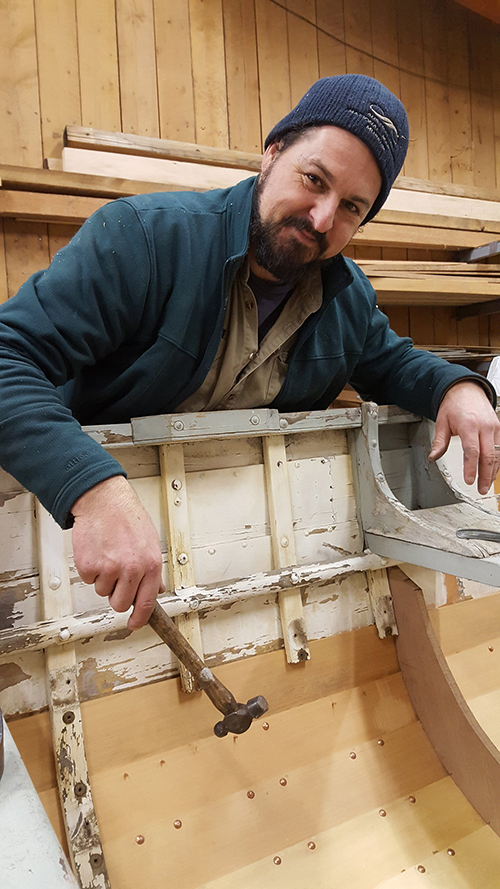
The as-yet-unnamed Franklin 29 is available for sale and all enquiries should be directed to the Wooden Boat Centre.
The team is currently devoted to their next mission, Undine and there’s a long road ahead, likely involving many late, cold winter nights. Cory and his team are working hard to match the vessel’s original timbers and revive the style and performance of Undine’s pedigree.
“We’re aiming to use like for like,” says Cody, referring to replicating the original in this modern incarnation. “For the hull, we’re using King Billy Pine, and for the cabin, Huon Pine. The deck will be ply and ‘glass, then painted.”
This is where experience and expertise are essential. “We rely on WEST SYSTEM 105 resin and 205m Fast Hardener in the cold for curing in a timely manner,” he states.
“At night, temperatures drop to 4C and a maximum of 17C during the day, depending on the weather. It can be freezing inside the workshop and breezy. So, to ensure quick curing we use the Fast Hardener – and as an added benefit, it makes people work faster too!
“The secret is when you’re working with a lot of people, to make small batches and work efficiently,” he adds.
“We use WEST SYTEM from ATL because their products are a known quantity, they’re consistent. When you use them a lot, you become confident they’re up to the task. And ATL provide technical support when we ask.”
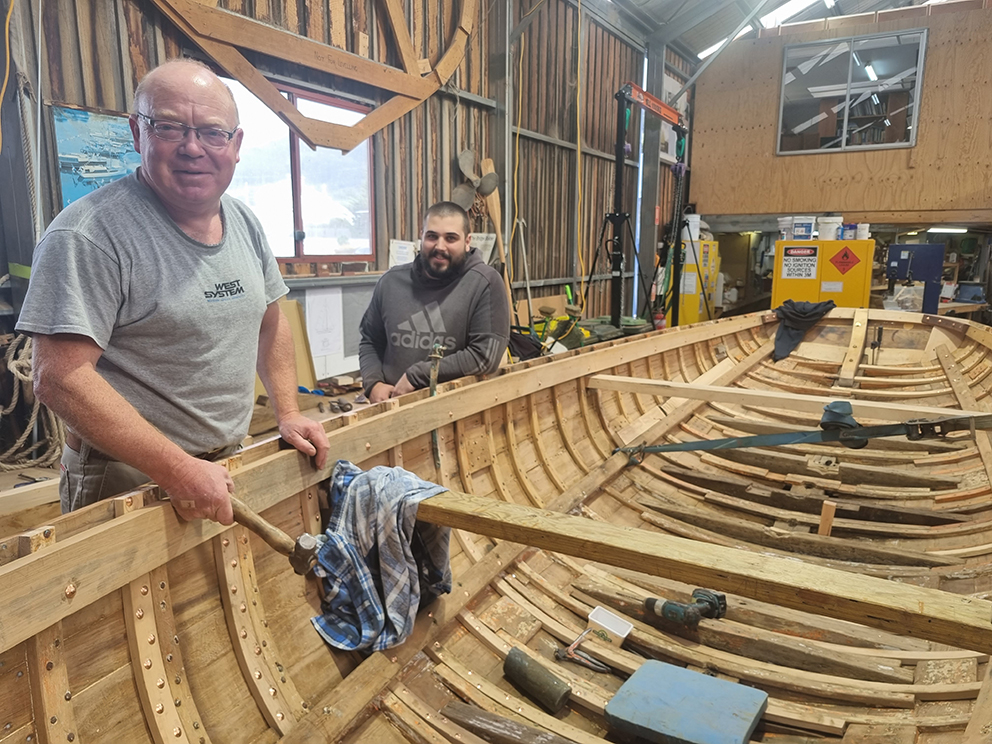
The AWBF is aiming to launch the resurrected Undine to compete for the first time in at least 40 years against other D-class vessels in the Derwent Worlds in February 2024, and the auction her at the close of the Rally.
“If this one is a success, we may be lucky enough to do more in the future,” says Cody. “There are many more out there in need of loving restoration and a second lease of life.”
atlcomposites.com.au
www.westsystem.com.au
woodenboatcentre.com
australianwoodenboatfestival.com.au
oystercovemarina.com.au
- Latest edition of Afloat Magazine
- Subscribe to Afloat Magazine
- Merchandise
- Tips for Selling Your Boat
- Boat Reviews
- Marine Directory
- Classifieds
- International
- News & Events
SIGN UP Today
to our eNewsletter for your chance to WIN!
- Seller Market Analysis
- Trade Your Yacht
- Vessel Donation
- Sold Yachts
- We Buy Boats
- Exclusive Listings
- Yachts for Sale
- New Yacht Builds
- Nautor Swan Yachts
- Sichterman Yachts
- Luxury Yacht Charters
- Search Charter Yachts
- Charter Management
- Luxury Events
- Team Members
- Boat Show Events
- North Report Magazine
- Testimonials
- +1.954.900.9988
Blog | Owner’s Guide to Yacht Classification
Yacht classification is a system used to categorize yachts based on various factors such as size, construction, and intended use. The specific classification categories and requirements can vary between different yacht classification societies, but some common classifications include:
- Pleasure Yacht: A yacht intended for leisure use, typically not engaged in commerce.
- Charter Yacht: A yacht that is available for hire for pleasure use, also known as commercial yacht.
- Large Yacht: A yacht that exceeds a certain size or gross tonnage.
- Small Commercial Yacht: A yacht that is used for commercial purposes but does not exceed a certain size or gross tonnage.
- Passenger Yacht: A yacht that is used to carry passengers for hire.
- Workboat: A yacht or vessel intended for work-related use, such as a survey vessel, cable layer, or other specialty use.
- Ocean Going: Yachts that are able to make ocean passages and are built and equipped to meet the requirement of such voyages
- Coastal: Yachts that are intended to operate in coastal and sheltered waters and meeting less stringent requirement than ocean going yachts.
The main differences between yacht classification societies are their specific rules, regulations, and requirements for yacht classification. While many societies have similar overall goals of ensuring that yachts meet certain standards of design, construction, and maintenance, they may have slightly different interpretations of these standards and how they should be applied.
Some societies may have stricter or more detailed rules and regulations than others. For example, one society may have more stringent requirements for fire protection, while another society may place more emphasis on stability calculations.
Another difference is the type of yachts they cover and the services they offer. Some societies focus primarily on pleasure yachts, while others also cover commercial yachts and workboats. Societies may also offer different levels of classification, such as “unrestricted” or “restricted” class, and this might vary depending on the intended use of the yacht.
Lastly, some societies have a more global presence than others, or have more experience or expertise in certain types of yachts or regions. This can be important for yacht owners who plan to take their vessel to different parts of the world and may need to comply with different regulations in different countries.
In short, yacht classification societies are similar in their overall goals, but they can have different rules, regulations, and requirements for yacht classification, different services and different areas of focus. Yacht owners should research and compare different societies to determine which one is the best fit for their specific needs and intended use of the yacht.
There are several yacht classification societies that provide certification and inspection services for yachts and other small vessels. Some of the most well-known include:
- American Bureau of Shipping (ABS)
- Bureau Veritas (BV)
- Germanischer Lloyd (GL)
- Lloyd’s Register (LR)
- RINA (Registro Italiano Navale)
- Det Norske Veritas (DNV) now known as DNV GL
These organizations are responsible for ensuring that yachts and other vessels meet certain standards of design, construction, and maintenance, and they issue certificates of compliance to vessels that meet these standards. They also conduct periodic inspections to ensure that vessels continue to meet these standards over time. Some of them also provide additional services such as collision avoidance, navigation and stability calculations and other specialized services.
Recent Stories
Embark on luxury: yachting in newport, ri with 26 north yachts, unveiling patagonia’s untamed beauty: explora lodge, an exclusive retreat for adventure seekers.

Talk to us Contact Our Team
I understand that by signing up I agree with 26 North’s Privacy Policy .
Welcome aboard!
We have added you to the newsletter.
We have received your information and an agent will get back to you ASAP
Sign up for Yoga On the Docks Tuesdays at 8 AM
We have received your registration. See you on the docks!
Yachting World
- Digital Edition

A pocket guide to the J Class yachts – the world’s most elegant racing fleet
- Toby Hodges
- March 19, 2017
Toby Hodges profiles the world's most beautiful fleet of classic racing yachts – the J Class
Shamrock V – JK3

J Class yacht Shamrock sailplan
LOA: 36.50m /119ft 9in · LWL: 26.7m/87ft 7in · Beam: 6.00m/19ft 8in · Disp: 166 tonnes
Original lines: Charles E Nicholson
Modified design: Dykstra Naval Architects
Launch year and yard: 1930, Camper & Nicholsons
Identifying features: The only wooden J and the smallest. Dark green hull with bronze deck fittings.
Current state: She has just had a refit in Palma after a long period under her past owner chartering, cruising and occasional racing.
Race prediction:Her smaller size means she will struggle against the other J Class yachts in real time – but she has the most experienced skipper and her recent mods are all aimed at making her competitive on handicap.
Skipper: Simon Lacey · Race Helmsman: Mike ‘Moose’ Sanderson

Photo: J Class Association / Gerhard Standop
Velsheda – JK7

J Class yacht Velsheda sailplan
LOA: 39.25m/128ft 9in · LWL: 27.8m/91ft 3in · Beam: 6.57m/21ft 7in · Disp: 180 tonnes
Launch year and yard: 1933, Camper & Nicholsons. Rebuilt by Southampton Yacht Services in 1997.
Identifying features: Dark blue hull, pinched transom and that iconic sharp J bow.
Current state: Continually optimised and very well prepared.
Race prediction: Highly experienced, well-gelled crew and a yacht that is looking particularly nimble and aggressive at the start. Despite surrendering size to the modern J Class yachts she’s a firm favourite to win any regatta.
Skipper: Barney Henshaw-Depledge · Race helmsman: Owner-driver
Helen Fretter goes racing on board J Class yacht Velsheda

Photo: J Class Association / Onne van der Wal
Endeavour – JK4

J Class yacht Endeavour sailplan
LOA: 39.31m/128ft 12in · LWL: 27.30m/89ft 7in · Beam: 6.68m/21ft 11in · Disp: 175 tonnes
Launch year and yard: 1934, Camper & Nicholson. Relaunched by Royal Huisman in 1989.
Identifying features: Royal ‘Endeavour Blue’ hull, clean deck, single deckhouse.
Current state: Completely refitted by Yachting Developments in 2010-11. Based between Palma and Cascais she is for sale through Edmiston and in prize condition.
Race prediction: Fully optimised and race ready, but is up for sale and now already unlikely to be ready in time for Bermuda.
Skipper: Luke Bines · Race helmsman: N/A (Torben Grael in 2012)
Video exclusive: what it’s like to sail the iconic J Class Endeavour

Photo: J Class Association / Jens Fischer
Ranger – J5

J Class yacht Ranger sailplan
LOA: 41.63m/136ft 7in · LWL: 28.80m/94ft 6in · Beam: 6.41m/21ft 0in · Disp: 203 tonnes
Original design: Starling Burgess and Olin Stephens
Modified design: Studio Scanu, Reichel Pugh, Fred Elliot and Dykstra Naval Architects
Launch year and yard: 2003, Danish Yacht
Identifying features: White hull with snub nose and spoon bow.
Current state: Refitted and optimised at Newport Shipyard 2016, where chainplates were moved forward and tracks modified to take a bigger headsail.
Race prediction: The heaviest J, but a rocket in flat water, such as in Bermuda’s Great Sound. A veteran crew whose consistency is Ranger’s trump card.
Skipper: Dan Jackson · Race helmsman: Erle Williams
Ranger J5 – the first completely new J Class yacht

Ranger , J5 RYS centenary 2015. Photo Paul Wyeth
Rainbow – JH2

J Class yacht Rainbow sailplan
LOA: 39.89m/130ft 11in · LWL: 26.90m/88ft 3in · Beam: 6.42m/21ft 1in · Disp: 167 tonnes
Original lines: William Starling Burgess
Launch year and yard: 2012, Holland Jachtbouw
Identifying features: Black hull, red bottom and modern grey rig with race boom.
Current state: Sold in 2015 by Chris Gongriep, the former owner of Holland Jachtbouw, she has since solely been used for cruising by her US owner who shows no signs of wanting to race, although she will be in Bermuda to watch.
Race prediction: Was cruised and raced extensively for a couple of seasons after she was built and has proven to be a supremely fast boat for her size in the right hands.
J Class yacht Rainbow – the Dutch destroyer
Hanuman – JK6

J Class yacht Hanuman sailplan
LOA: 42.19m/138ft 5in · LWL: 27.50m/90ft 3in · Beam: 6.60m/21ft 8in · Disp: 180 tonnes
Launch year and yard: 2009 Royal Huisman
Identifying features: Carries the old Endeavour II sail number JK6 – but a totally modern day reinterpretation of Sopwith’s second boat, built in aluminium.
Current state: Her weight and stability were optimised at Newport Shipyard in 2016 and she was also fitted with a new mast and rigging, plus a new furling headstay.
Race prediction: With her same core Comanche/Puma crew and Ken Read on the wheel, this is a highly race-oriented J Class yacht.
Skipper: Greg Sloat · Race helmsman: Ken Read
Inside J class yacht Hanuman

Lionheart JH1

J Class yacht Lionheart sailplan
LOA: 43.4m/142ft 5in · LWL 27.2m/89ft 3in · Beam: 6.55m/21ft 6in · Disp: 180 tonnes
Original lines: Starling Burgess and Olin Stephens
Modified design: Hoek Design
Launch year and yard: 2010, Bloemsma and Claasen Jachtbouw
Identifying features: Black hull and rig, bulwarks giving a high freeboard effect, two deckhouses.
Current state: Constantly upgraded, Lionheart has new North raw sails with plans to build more sails before Bermuda.
Race prediction: Lionheart is consistently optimised, has some key pros and a fantastic crew spirit. Should be finishing in the top three in Bermuda.
Skipper: Toby Brand · Race helmsman: Owner-driver · Tactics: Bouwe Bekking
J Class yacht Lionheart J/H1 – replica of an original that was never built

Photo: J Class Association / Thierry Martinez

J Class yacht Topaz sailplan
LOA: 42.7m/140ft 1in · LWL: 27.8m/91ft 3in · Beam: 6.75m/22ft 2in · Disp: 180 tonnes
Original lines: Frank Paine
Launch year and yard: 2015, Holland Jachtbouw
Identifying features: Longest waterline of all the Js (for which there is a sail area penalty) she has a striking Art Deco interior and a dark blue hull with turquoise antifoul.
Current state: New and raring to go.
Race prediction: With her fuller volume forward, longer waterline and shorter keel, Hoek believes she will be the fastest J Class downwind and in light airs. The crew has practised hard since last year and now has top big boat helm in Holmberg.
Skipper: Romke Lopik · Race helmsman: Peter Holmberg
New J Class yacht named Topaz is launched – and the design team says she is “absolutely stunning”

Photo: J Class Association / Carlo Borlenghi

J Class yacht Svea sailplan
LOA: 43.6m/143ft 1in · LWL: 27.6m/90ft 7in · Beam: 6.65m/21ft 10in · Disp: 180 tonnes
Original lines: Tore Holm
Launch year and yard: 2017, Bloemsma / Vitters
Identifying features: Dark grey metallic hull, near flush ultra-clean, ergonomically optimised deck with low single doghouse and huge 8ft diameter wheel that turns in a well that extends down to the keel frames.
Current state: Just launched.
Race prediction: Tore Holm was a gifted Metre designer and Svea looks like a fast upwind boat, with a race oriented deck design and a slippery underwater shape. It’s asking a lot of her crew to be competitive for 2017.
Skipper: Paul ‘PK’ Kelly
Race helmsman: Owner driver
Nine Js and counting: J Class Svea J-S1 is sold and under construction at Vitters
The history of the J-Class
The Js are inextricably linked with the America’s Cup as, barring Velsheda , all were built for the purpose of America’s Cup racing. From 1929 to 1937, 20 J Class yachts were designed. Ten of these went on to be built, with six racing in the America’s Cup finals. A modern J Class yacht’s lines can only be taken from the original designs, ensuring the fleet’s look endures.
The J Class has its roots in the oldest international yacht race in the world, the America’s Cup.

Our Heritage
Considered some of the most beautiful yachts ever built, the story of the J Class is defined by fierce transatlantic competition for the America’s Cup, followed by an era of steep decline, and the modern-day revival.

The J Class includes a mixture of refitted surviving yachts along with a number of new yachts faithfully built to original hull lines from 1930’s designs, with more yachts currently in build.
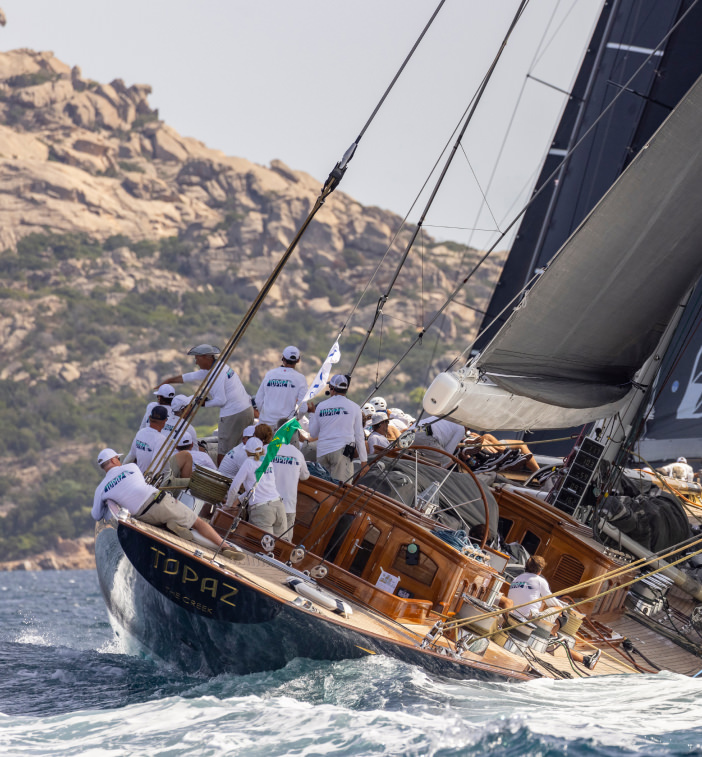
The J Class Association was founded in 2000 to protect the interests of the Class, present and future, and organises an annual calendar of racing for these magnificent yachts.
2024 Calendar
The Superyacht Cup Palma
Palma, Spain
8 - 14 September
Maxi Yacht Rolex Cup
Puerto Cervo, Sardinia
5-11 October
America's Cup J Class Regatta
Barcelona, Spain
We love them because they are sublimely beautiful, utterly impractical and fiendishly demanding.
Elizabeth Meyer
Modern-day saviour of the J Class

Latest news
J class duo velsheda and hanuman heading to saint barths bucket.

The renowned Saint Barths Bucket superyacht regatta has long been popular with J Class yacht owners and crews, many of whom have enjoyed success at the Caribbean spring showcase event over recent years.
Svea find more joy in Ibiza

The well drilled Svea team continued their winning ways when the Swedish flagged recent winners of the Maxi Yacht Rolex Cup raced against Topaz under the J Class Association rule last week at the third edition of Ibiza JoySail.

This site uses cookies to enhance your experience. By continuing to browse the site, you consent to the use of cookies. View our Privacy Policy for more information.

The global authority in superyachting
- NEWSLETTERS
- Yachts Home
- The Superyacht Directory
- Yacht Reports
- Brokerage News
- The largest yachts in the world
- The Register
- Yacht Advice
- Yacht Design
- 12m to 24m yachts
- Monaco Yacht Show
- Builder Directory
- Designer Directory
- Interior Design Directory
- Naval Architect Directory
- Yachts for sale home
- Motor yachts
- Sailing yachts
- Explorer yachts
- Classic yachts
- Sale Broker Directory
- Charter Home
- Yachts for Charter
- Charter Destinations
- Charter Broker Directory
- Destinations Home
- Mediterranean
- South Pacific
- Rest of the World
- Boat Life Home
- Owners' Experiences
- Interiors Suppliers
- Owners' Club
- Captains' Club
- BOAT Showcase
- Boat Presents
- Events Home
- World Superyacht Awards
- Superyacht Design Festival
- Design and Innovation Awards
- Young Designer of the Year Award
- Artistry and Craft Awards
- Explorer Yachts Summit
- Ocean Talks
- The Ocean Awards
- BOAT Connect
- Between the bays
- Golf Invitational
- Boat Pro Home
- Pricing Plan
- Superyacht Insight
- Product Features
- Premium Content
- Testimonials
- Global Order Book
- Tenders & Equipment
J Class Yachts
Go inside the world of the iconic J Class yachts with reports on board these famous vessels, interviews with their owners and coverage of the J Class World Championships. Boat International is the official media partner of the J Class Association.
LATEST J CLASS NEWS AND FEATURES
Boat presents, from our partners, sponsored listings, yachts for sale, sailing news, more j class news and features.
RANGER – THE ‘SUPER J’
Contractionary policies in response to what was an era of recession globally, leading to reduced aggregate demand and the fundamental cause of the Great Recession were hardly conducive conditions for the building of large race yachts.
It was thought that the J-Class could well sound the death-knell for the America’s Cup as a sporting contest and even the New York Yacht Club members, often insulated to a degree from the worst of the depression, were sailing smaller boats for club racing – most notably those rating to the 12-Metre and K-Class rules.
Against this dire economic backdrop, that incidentally was about to get worse through 1937-1938 before it got better, the Commodore of the Royal London Yacht Club, Richard Fairey, entered a speculative challenge - after surreptitious enquiries had been made - with a design that measured to the lower end waterline length permitted by the Deed of Gift and measure to the 65 feet New York Yacht Club rating rule. Not unreasonably, Fairey argued in a communication to Junius Morgan, Commodore of the NYYC, that: “I feel very strongly that the present J-Class boats are altogether too large and too expensive and that their design has been overshadowed by the necessity of fitting them out with accommodation for the owner and his guests when living aboard.” Further concerns surrounded the safety of the J-Class and whether they were suitable in anything above a Force 3 with particular note around the new duralumin rigs and their seaworthiness. The New York Yacht Club, however, were not in the mood to compromise on their premier competition.
Recognising this unwillingness and the rejection of the Royal London Yacht Club’s challenge, Thomas Sopwith commissioned Camper & Nicholson of Gosport to build what was hoped to be another technical wonder, Endeavour II, that was laid down in February 1936 and launched on 8th June 1936. Its flag was to the Royal Yacht Squadron but at the time of launch, no formal challenge had been proposed as both Charles Earnest Nicholson, the boat’s designer, and Sopwith felt that a long period of working up and crew training would be the key to a successful challenge. That challenge was duly posted to the NYYC by August 1936 for the Endeavour II rating to the 76-foot rating rule as recognised by America’s premier club and seeking for racing to start in July 1937.
Early assessment of Endeavour II was mired by the collapse of two masts, but the Americans were concerned by the seemingly devastating performance of the boat against Endeavour I in light airs, where it was widely assumed that she had a significant advantage over the successful defender of 1934, Rainbow. The New York Yacht Club formed a syndicate again under the command of Harold ‘Mike’ Vanderbilt who duly commissioned Starling Burgess as lead designer but also made the crucial decision to create a design team by bringing onboard the fast-rising star of yacht design in Olin J. Stephens. Burgess’s star had been falling for a while in the eyes of the members of the New York Yacht Club with the view, widely expressed, that the speed deficiencies of Rainbow and Enterprise were only rectified by the brilliance of Vanderbilt, Bliss and Hoyt in the afterguard. Bringing Olin Stephens in was a nod to the future and a check on Starling Burgess.
Tank-testing was nothing new in the America’s Cup, G.L Watson was tank-testing in 1900, but the advance in the way those tests were undertaken, and the data extracted, particularly in terms of heel angle and side force, saw the 1937 design project for Ranger advance yacht design to a whole other scale. Using the Stevens Institute testing tank at Hoboken under the command of Professor Ken Davidson, Stephens and Burgess both drew lines for two models each to be tested. The final design for Ranger has, however, become something of legend with no clear view on whether it was from the hand of Burgess or Stephens as the models were adapted during testing with input from both, but what became evident was that the result was a sensation.
Olin’s brother, Rod Stephens, was brought in for the design of the rig whilst Starling’s brother, Charles Burgess, took charge of the mast design. These were crucial areas as Vanderbilt insisted on using some sails from the Rainbow campaign – in particular an unused mainsail that he had been saving – and much concentration was given to more efficient sail-handling. Meanwhile, the final design for Ranger’s hull profile had the mark of Olin Stephens writ large with a low aft profile and the famous snub-nosed bow whilst Vanderbilt himself had considerable input in the final waterline length of 87 feet having seen a marked improvement in 1936 when he added a 10-ton lead shoe to Rainbow’s keel for the annual New York Yacht Club cruise races.
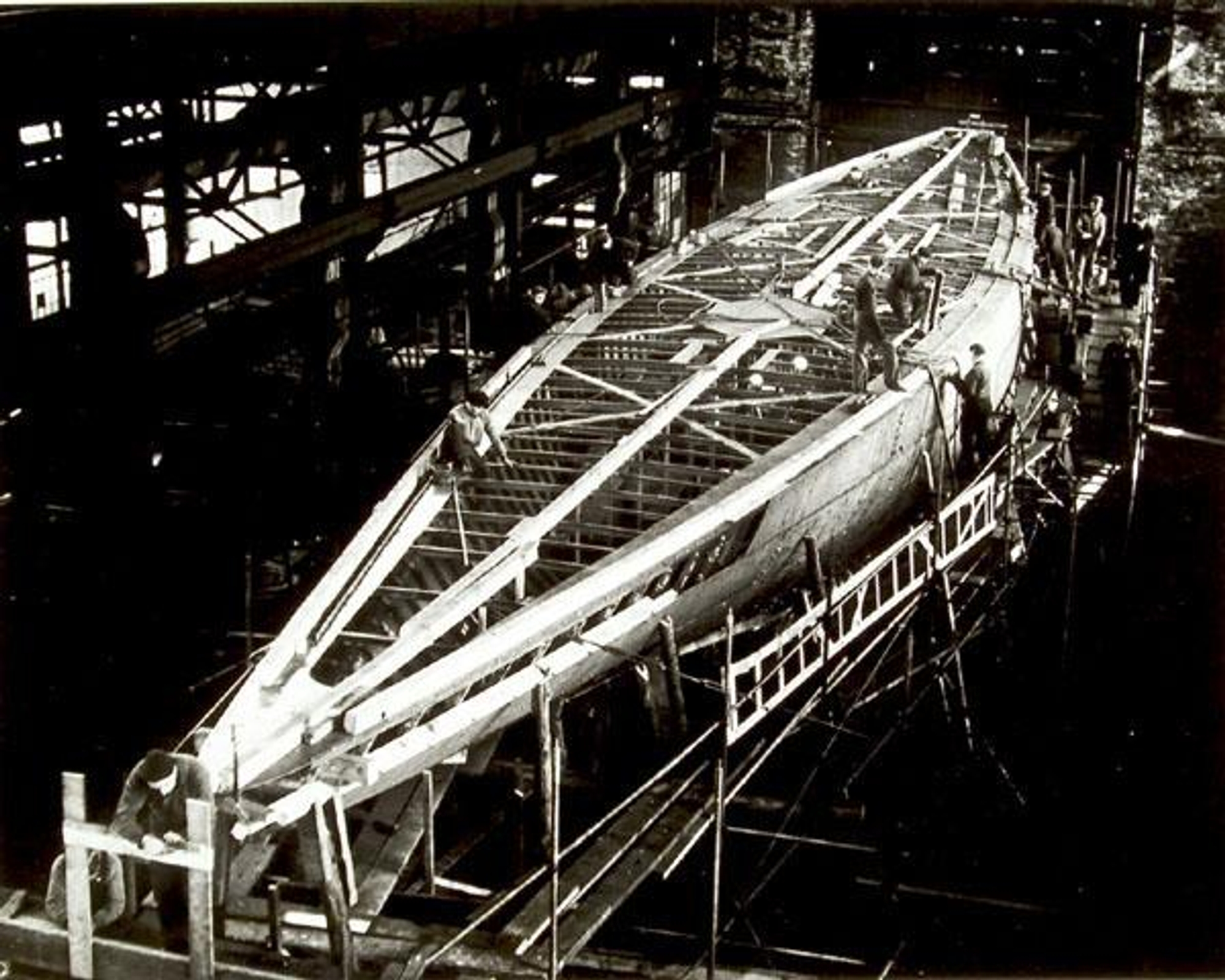
The final model that produced the design was number 77-C, one of the first tested, and the Bath Iron Works Boatyard was commissioned for the build, but worsening economic climes caused Ranger to be built at cost using highly efficient construction methods. Filler was almost eliminated in the process with flush riveted steel plating forming the hull and cedar was laid on steel for the decks to reduce both weight and cost. The designers went novel for the rudder creating a negative buoyancy structure with a watertight air compartment and a very low clearance to the hull and Ranger was launched on May 11th, 1937, after a christening ceremony with Mrs Gertrude Lewis Vanderbilt (nee Conway) breaking the customary champagne on the snub bow.
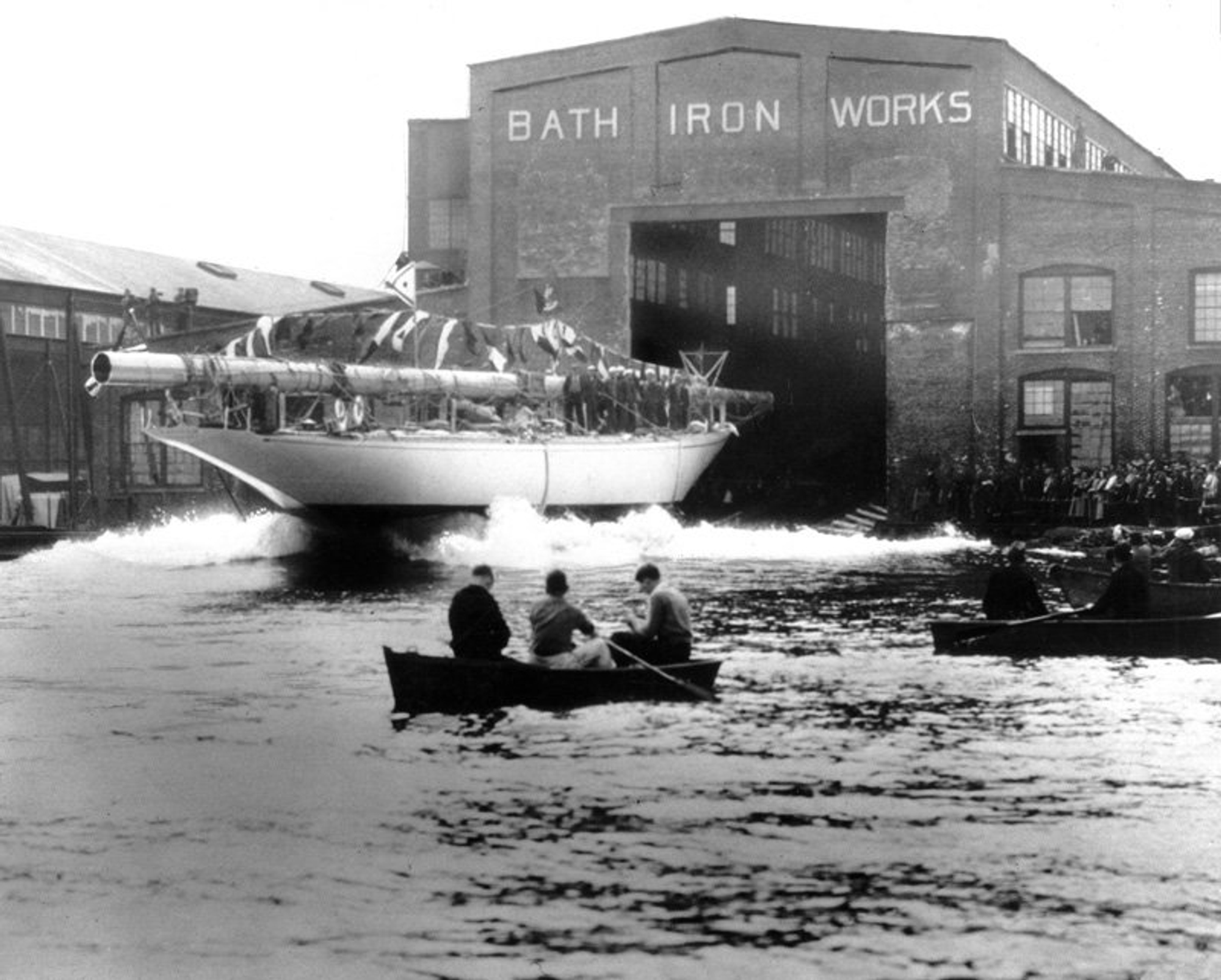
Just like the problems on Endeavour II, Ranger experienced a mast failure on its tow down from Bristol, Maine in a heavy seaway thus proving the fragility of the duralumin masts as feared and in a race against time, the old 1934 mast of Rainbow was stepped whilst a replacement was re-fabricated. At this time, in May 1937, Endeavour II arrived in Newport under tow having sailed the last 720 miles owing to a significant Atlantic storm – remarkably she arrived unscathed minus some rusting on the spar.
Ranger’s preliminary races against Rainbow and Yankee proved that she was a rocket-ship of sorts. Stiff, fast and devastating on a reach, she won each of the three races and entered the defender trials with the notion that she was ‘unbeatable’ – and by the time her replacement mast was stepped, and the old 1934 sails replaced by modern ones, the trials were to be a one-sided affair. Indeed, in one race against Yankee when Ranger won by a massive margin, she did so at an average speed of some 11 knots and set the fastest recorded time ever over the America’s Cup course. The omens were good for a successful defence and Ranger was appointed without question by the New York Yacht Club committee.
Endeavour II’s work-up that summer was almost solely against Endeavour I in a series of practice sessions that roused both suspicion and derision by the yachting journals in America. Sopwith was obsessed with speed trials and manoeuvres, setting exactly the same sail plan on both boats and then proceeding through a set of drills before long runs on opposite tacks before coming back together and then halting the session. De-briefings were long, and crew-work was honed as the memory of poor sail-handling in 1934 was sought to be avenged. Endeavour II was observed by the Americans as being faster on all points of sail than her much-admired predecessor and on July 1st, 1937, the Royal Yacht Squadron confirmed to the NYYC that Endeavour II would be lining up as challenger for the America’s Cup (there was a thought that Sopwith might try and swap out Endeavour II for Endeavour I but this pure media speculation).
Could she match the pace of Ranger though who had spent that summer on their sail wardrobe and in typical Vanderbilt fashion, sought improvements all over?
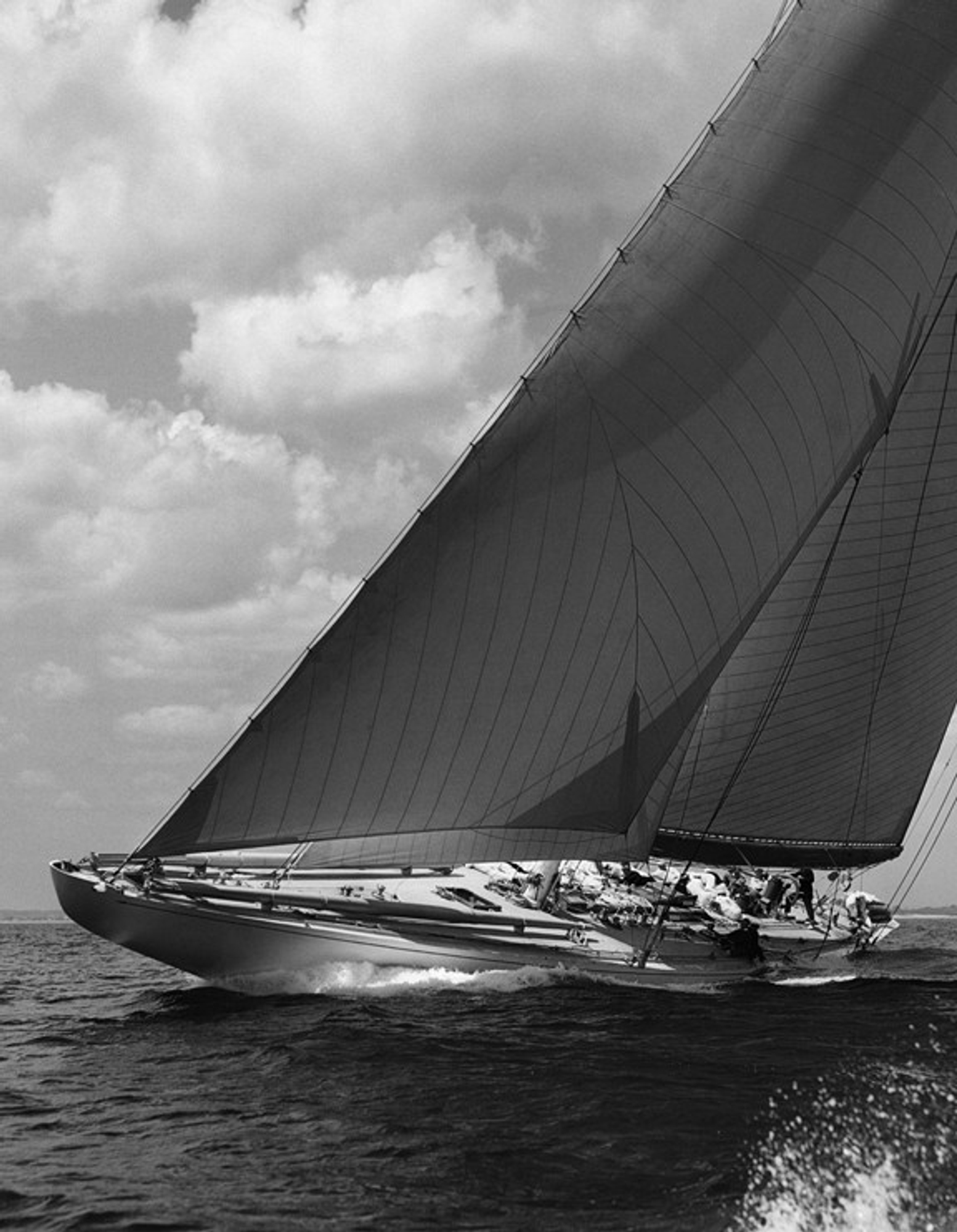
Ranger’s sail inventory that summer was the most remarkable seen on a J-Class to date. The introduction of the enormous 250%, 175% and 135% quadrilateral jibs that were set over over-sized staysails that had been tacked further forward to produce an effective ‘slot’ gave Ranger power unseen before on these boats – and a commensurate beefing up of winches and blocks to cope with the loads was thoroughly worked up through that summer after notable failures in the trials. Vanderbilt was convinced that as much as the waterline length had been a determining factor in 1934, that in 1937 the major gains would be made aloft. Ranger’s mainsail inventory included one from Enterprise of 1930, updated by the City loft of Ratsey’s, a staysail from Vanderbilt’s M-Class ‘Prestige’ and great advances were made both in the spinnaker design, particularly the ballooner, and in how they were handled in manoeuvres. Vanderbilt even mastered a way of gybing with the spinnaker left up that was ultimately outlawed for 1937 but became standard thereafter.
By contrast, Endeavour II’s sail programme had seemingly not advanced from the standard plans of Endeavour I in 1934 and the early loss of two masts in early trials led to caution creeping in on Sopwith’s behalf to push the rig development. It was a fatal error in competitive terms but both boats came to the start of the America’s Cup in 1937 wary of the other and after such a close fight in 1934, the American media assumed that this would be a desperately closely affair once more with some even arguing that a Cup abroad would be good for the future of the sport.
The first race dawned with very light winds on July 31st, 1937, causing the race committee to postpone for 45 minutes to allow the expected breeze to fill in for the planned 30 mile windward / leeward test. Endeavour II got the better of the start, crossing the line ahead by three seconds to leeward of Ranger and able to squeeze up, forcing Vanderbilt to tack away for clear air after 11 minutes.
With clear wind now, and despite Sopwith throwing in a tack to try and cover, Ranger just eased away with Vanderbilt steering loose for speed before coming back to course and after an hour of sailing had left the English challenger almost a mile dead astern. With the breeze freshening, both boats called for a sail change. Vanderbilt was getting increasingly uncomfortable with the 250% quadrilateral in an un-tested wind-range so called for the 175% quadrilateral but the crew, in error, launched the 135% and with Endeavour II swapping from genoa to 175% quadrilateral, for a while the American skipper, although with a healthy lead said that Ranger felt “dead in the water.”
By the top mark, Ranger had clung on and rounded with a lead in excess of six minutes and launched a balloon jib with a light staysail as the wind backed. Sopwith was in gambling territory and sailed high once around the weather mark on the thinking that the incoming breeze with layers of mid-fog would back the breeze further. In short order, the two boats lost sight of each other and as the wind came aft, Ranger launched a light parachute spinnaker formerly seen onboard Yankee and romped home. The margin was astonishing – 17 minutes and 5 seconds – and Endeavour II was in danger of missing the time-limit. Spectators, that numbered some 300 craft of all shapes and sizes, had never seen anything like it in the modern America’s Cup. The early writing was on the wall for the Challenger.
A fresher breeze awaited the yachts for race two with a triangular course set and it was Endeavour II that again made the better start. The practice that Sopwith had executed in the tune up with Endeavour I paid handsomely at close-quarters and a tack beneath Ranger in the dying moments of the pre-start was a textbook move. Ranger, now sitting in backwind dirty air was forced to tack off onto port soon after the start but on the tack back to head out to the left of the course, a top block for the quadrilateral sheeting position exploded and the crew struggled to get optimum trim.
Endeavour II was looking good to maintain her lead and at various points of the first leg she could have easily tacked and crossed, but the race was about to be turned on its head as the English sailed into a light, heading patch of breeze that slowed her dramatically. Ranger came up astern, hit the same pattern and immediately Sopwith tacked in the hope of getting up to speed and crossing the Americans’ bow. Vanderbilt maintained better speed and seeing the English dead in the water, tacked with way under her to leeward and with better crew-work emerged with pace on port tack. Pretty soon Ranger was eking up onto Endeavour II’s line, forcing her to tack off and it was one-way traffic. Ranger extended on the second half of the beat to round 10 minutes 25 seconds up.
With her 250% quadrilateral set – a sail that was nicknamed the ‘Mysterious Montague’ for its inherent cloth being specially developed by DuPont DeNemours Company with rayon and a special coating of aircraft dope – Ranger extended on both reaches of the triangular course. Sopwith had no answer for her waterline speed and superb sail inventory and the winning margin of 18 minutes and 32 seconds was another hammer-blow to the English who simply couldn’t match the super-J creation of Vanderbilt, Burgess and Stephens.
Sopwith called a lay-day to haul Endeavour II out of the water, convinced that she had damaged her centreboard through tangling with a lobster buoy or some other object under the water, so inexplicable was the speed loss on that first beat. “Ranger was pointing much higher, and we could not point any higher than we were. We lost 10 minutes in 5 miles. It is possible we picked up one of those lobster pots,” Sopwith commented afterwards whilst also insisting that some 5,070 pounds of lead were removed from the ballast to improve the light-weather performance. It was time to gamble.
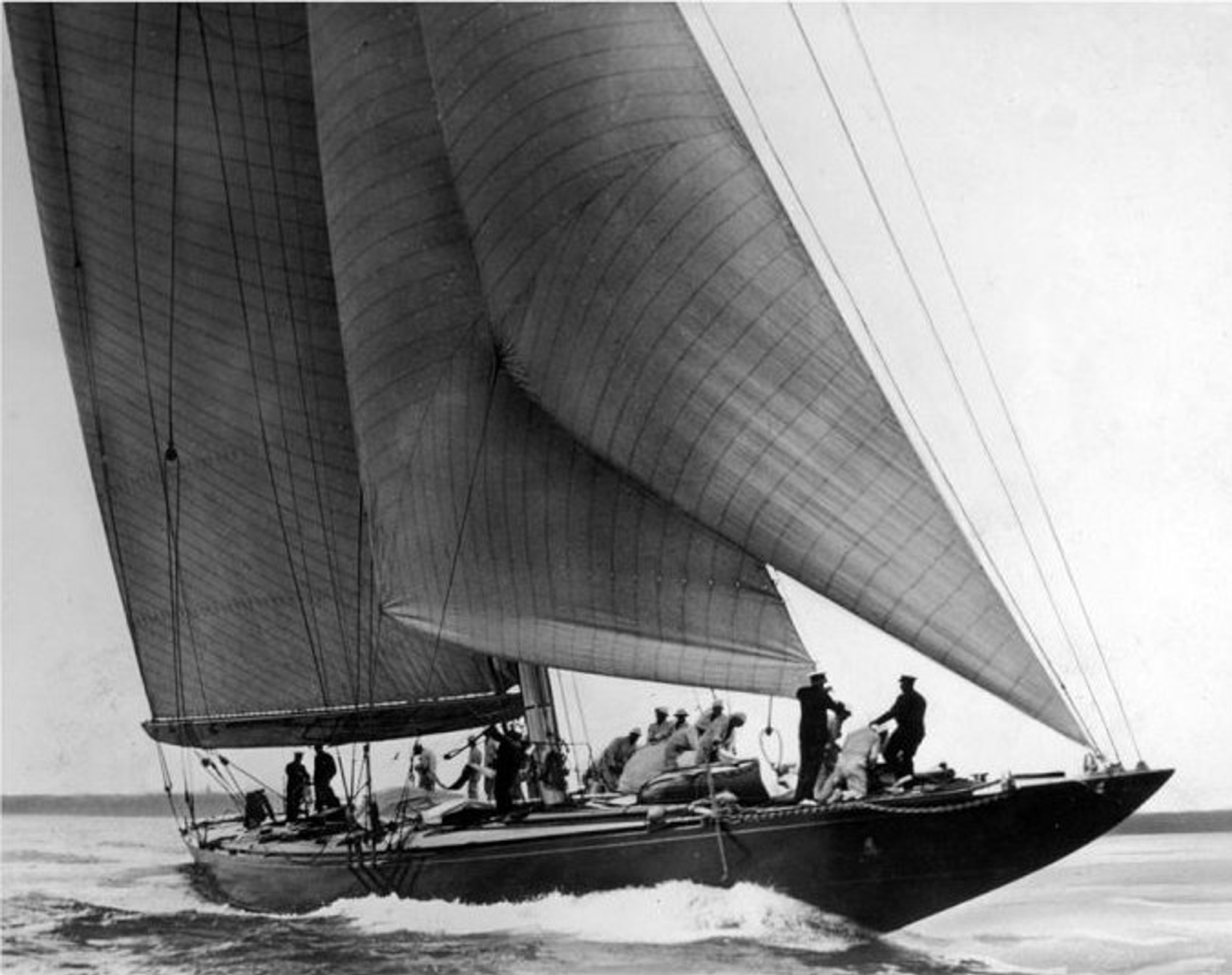
Race three, always a crucial race in these first to four America’s Cup battles where the pendulum can swing or momentum can be carried forward, was do or die for Sopwith but Vanderbilt, smarting from the Dailies taking issue with his starting prowess was more than up for the fight. The windward / leeward course was set in a steady 10 knots of breeze, and it saw the two magnificent J-Class yachts circling aggressively in the pre-start before heading to opposite ends of the start-line on opposite tacks at the gun. Vanderbilt aced the start at the leeward end on starboard tack whilst Sopwith came across 18 seconds down at the other end on port. Sopwith certainly felt that with the reduced ballast, he had the measure of Ranger in a tacking duel and initiated the play which resulted in Ranger’s winch jamming again forcing the quadrilateral sail to be mis-sheeted halfway up the beat.
The wind Gods of Newport however saved the day for Vanderbilt as she sailed a few degrees off the wind but into a favourable shift, keeping Endeavour II on her stern, that allowed Ranger to tack and sail into a lead of 4 minutes and 13 seconds at the top mark – incidentally the fastest recorded time for a 15 mile beat to windward in America’s Cup history.
A split decision upon rounding the windward mark saw Ranger gybe off immediately whilst Endeavour II bore away onto the port gybe with both boats setting spinnakers as the wind increased to 14 knots. For the next 14 miles the boats converged on opposite gybes with Ranger holding the lead but Endeavour II looking the more likely to maintain a direct line to the finish without the need for the costly manoeuvre of gybing. A wind-shift, just a mile from home however, scuppered any chances and both boats were forced to gybe to make the finish with a shy reach to the line calling for a ballooner to be re-launched on the new gybe on both boats. Ranger held on and crossed with a 4 minute 7 second delta and it was match-point to the Americans.
For what proved to be the final race of the America’s Cup in 1937, and in fact the last time that the regatta would be run for the next 21 years, it failed to live up to its billing and an English fight-back was scuppered when Sopwith went over the start-line early. Aggressive tactics from Vanderbilt in the final circle saw Ranger trapping Endeavour II forward and with nowhere to run, she was forced over and Sopwith had to dial away into a gybe and re-cross, losing a minute and fifteen seconds in the process.
Ranger was now unstoppable, sailing in clear air, and matching Endeavour II tack for tack with no discernible loss of speed in the fresh breeze. Vanderbilt had insisted on setting a flat-cut mainsail from the 1930 wardrobe inventory of Enterprise and it was a masterstroke. By the windward mark she was 4 minutes and 5 seconds up and with her 250% quadrilateral set, she powered to the wing mark and despite Endeavour II shaving 30 seconds on that leg, the two boats were even on the final reach to the finish, and it was a resounding win to the Americans of 3 minutes and 37 seconds.
At the finish line, Vanderbilt handed the wheel to Olin and Rod Stephens to cross in a remarkable gesture of recognition at their efforts in producing what was undoubtedly the finest yacht in the world at the time – and considered even today, as the greatest yacht ever to compete in the America’s Cup. She was a marvel of the age and a testament to American design, astute build in strained financial times and Vanderbilt’s undeniable prowess at taking a boat to its racing limits. In subsequent races that summer, she was untouchable, beating all-comers and stamping her authority on the global yachting scene as the marker by which the era would be judged.
For the English it was another disappointment. It was to be T.O.M. Sopwith’s last hurrah in the America’s Cup but he was proud of his efforts saying: “We have had a series of the most wonderfully close races and I find the greatest difficulty in expressing my gratitude to our crew, amateur and professional, for the wonderful work they have done – they have all worked like slaves. May I say that we are not downhearted.”
The America’s Cup in 1937 was the last of the J-Class in the competition. With a pause for the Second World War, the next regatta in 1958 would see the 12-Metre rule adopted and the graceful lines of some of the most iconic yachts ever created would forever more be for the history books or those with deep pockets in modern times to restore, re-build or recreate those fabulous yachts. Only ten J-Class yachts were built, six in America and four in Great Britain, although several boats of the ‘big class’ of the era were adapted to conform to the J-Class rule. It was truly a ‘golden era’ and one that put the America’s Cup very much at the pinnacle of the yacht racing world.

IMAGES
VIDEO
COMMENTS
Demystifying yacht classification : Class A, B, C and D. Since 1998, CE certification is required for all recreational boats entering or being sold in Europe obliging boat manufacturers to respect certain building and security standards. Therefore, yachts ( boats ) are classified into four categories depending on their aptitude to confront ...
Class Certificate: This mainly deals with the yacht's hull, machinery, electrical equipment and outfitting. International Load Line Certificate : This certifies the weather-tightness of the yacht. Safety Radio Certificate : This is applicable if gross tonnage exceeds 300GT This concerns the radio communication and distress installations.
Class B (yachts over 50 ft): Sunnseeker 52 fly, 55 fly , 66 fly, 68 fly, Sport Yacht 74, 76 Yacht. Azimut 50 fly, 55 fly, 60 fly, S6 and all Atlantis. Princess : all yachts under 70 ft. Princess Y72, Y78 and less. Ferretti 580 fly. All Absolute. All Fairline. All Beneteau & Jeanneau & Monte Carlo 52. All Searay except L650. All Cruisers Yachts ...
Have you ever wondered what the different Beaufort scales are and what CE categories A, B C and D boats actually mean? In this video, I walk you through what...
Owners moving from smaller yachts into those over roughly 80 feet will quickly learn a new alphabet: ABS, DNV, BV, LR, RINA, and more. These are organizations that set rules governing the construction, maintenance, and operation of yachts. Called "classification societies," there are 13 members of the International Association of ...
As a consequence, it is either "in" or "out" of "Class". In summary, Class Notations on Yachts will tell you a lot about the building quality and condition of each vessel and its components on an annual basis, according to the excellence of its construction and its adjudged continuing soundness. A yacht that has been designed and ...
Not all of them class yachts, and of those who do, not all class smaller yachts. The American Bureau of Shipping (ABS), for instance, does not class yachts under 24 meters, or about 79 feet, in overall length. Each society also has different sets of rules and guides, several of which will be applicable to any given yacht.
The Derwent Class ('Ds' to those in the know), is the oldest racing class in Australia. The D is a one-design racing yacht designed by naval architect, AC (Arthur Carlyle) Barber in the 1920s for competing on the River Derwent and D'Entrecasteaux Channel, Tasmania. In his prodigious career, Barber designed RANI, the winner of the first ...
The J Class - so named because it was the letter allocated to its particular size by the Universal Rule to which the yachts were built (K and M Class yachts were, for example, shorter on the ...
Yacht classification is a system used to categorize yachts based on various factors such as size, construction, and intended use. The specific classification categories and requirements can vary between different yacht classification societies, but some common classifications include: Pleasure Yacht: A yacht intended for leisure use, typically ...
Discover the yachts in the J Class Association. About Yachts History News Events Gallery Partners. Next event: 19-22 June. The Superyacht Cup Palma. Yachts. In total nine J Class yachts are currently active, including three original surviving Js - Velsheda, Shamrock and Endeavour - and six replicas that have been built since 2003; Ranger ...
J Class yacht Velsheda sailplan. LOA: 39.25m/128ft 9in · LWL: 27.8m/91ft 3in · Beam: 6.57m/21ft 7in · Disp: 180 tonnes. Original lines: Charles E Nicholson. Modified design: Dykstra Naval ...
Universal Rule. J Class yachts Velsheda, Topaz and Svea downwind legs. The J Class is one of several classes deriving from the Universal Rule for racing boats. The rule was established in 1903 and rates double-masted racers (classes A through H) and single-masted racers (classes I through S). From 1914 to 1937, the rule was used to determine ...
Ranger is a 41.55 metre replica of the J Class yacht of the same name, which was built for the 1937 America's Cup by a syndicate led by railroad heir Harold Vanderbilt. Starling Burgess and Olin Stephens had been asked to produce eight sets of lines and the one selected as most suitable for the conditions expected off Newport, Rhode Island — design number 77C — was one of Burgess ...
In total nine J Class yachts are active now with six replicas having been built since 2003; Ranger, Rainbow, Hanuman, Lionheart, Topaz and Svea. The J Class Association. The J Class Association (JCA) was founded to protect the interests of the Class, present and future. Among its responsibilities it monitors and agrees the veracity of designs ...
The J Class Association was founded in 2000 to protect the interests of the Class, present and future, and organises an annual calendar of racing for these magnificent yachts. 2024 Calendar. 19-22 June.
J Class Yachts. Go inside the world of the iconic J Class yachts with reports on board these famous vessels, interviews with their owners and coverage of the J Class World Championships. Boat International is the official media partner of the J Class Association. Editorial Features. Svea: Inside the newest member of the J Class fleet.
Watch our unique footage of sailing the 1934-built J Class Endeavour. Yachting World's Toby Hodges had the chance to sail her and takes a look around Becom...
The windward / leeward course was set in a steady 10 knots of breeze, and it saw the two magnificent J-Class yachts circling aggressively in the pre-start before heading to opposite ends of the start-line on opposite tacks at the gun. Vanderbilt aced the start at the leeward end on starboard tack whilst Sopwith came across 18 seconds down at ...
The unique ice-class luxury yachts of the Radisson Royal Moscow Flotilla navigate the Moscow river 365 days a year, regardless of the season or the weather outside. Gorky Park Pier is the second pier in the city from where the Flotilla yachts depart. Let yourselves be amazed by the stunning views and the elegant mastery of our chef as you pass through the very heart of Moscow surrounded with a ...
Moskva, formerly Slava, was a guided missile cruiser of the Russian Navy.Commissioned in 1983, she was the lead ship of the Project 1164 Atlant class, named after the city of Moscow.With a crew of 510, Moskva was the flagship of the Black Sea Fleet and the most powerful warship in the region. The cruiser was deployed during conflicts in Georgia (2008), Crimea (2014), and Syria (2015).
We invite you on a river cruise aboard a premium class panoramic yacht starting from the main Moscow pier City-Expocentre. During the Moskva river walk you'll have impressive views of the city's main architectural sights - Vorobyovy Hills, the main building of Moscow State University, the Kremlin, the Cathedral of Christ the Saviour, the ...
Yacht of the Radisson Royal flotilla. Best water route in Moscow. Panoramic views of the capital from the water in winter and in summer. Restaurant with signature cuisine. Next tour: 1600 ₽. Learn more. Radisson Royal Class Cruise. 2,5 hours.